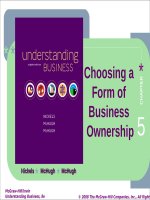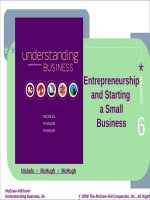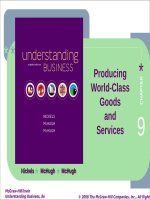Understanding business 11th by mchugh nickels chap015
Bạn đang xem bản rút gọn của tài liệu. Xem và tải ngay bản đầy đủ của tài liệu tại đây (5.16 MB, 52 trang )
CHAPTER 15
Distributing
Products
McGraw-Hill/Irwin
Copyright © 2015 by the McGraw-Hill Companies, Inc. All rights reserved.
LEARNING OBJECTIVES
1. Explain the concept of marketing channels and their
value.
2. Demonstrate how intermediaries perform the six
marketing utilities.
3. Identify the types of wholesale intermediaries in the
distribution system.
15-2
LEARNING OBJECTIVES
4. Compare the distribution strategies retailers use.
5. Explain the various kinds of nonstore retailing.
6. Explain the various ways to build cooperation in
channel systems.
7. Describe logistics and outline how intermediaries
manage the transportation and storage of goods.
15-3
REED HASTINGS
Netflix
• Almost singlehandedly
ended the era of brick and
mortar video rentals.
• In college, Hastings spent
his summers training with
the Marines and joined the
Peace Corps.
• Was inspired to start Netflix
after racking up a $40 late
fee.
15-4
NAME that COMPANY
This U.S. company is known for having low prices
all the time. One way it keeps prices low is by
eliminating as many wholesalers as possible and
doing all the wholesale function itself.
Name that company!
15-5
WHAT are MARKETING
INTERMEDIARIES?
LO 151
• Marketing Intermediaries Organizations that
assist in moving goods and services from businesses
to businesses (B2B) and from businesses to
consumers (B2C).
• They are called intermediaries because they’re in
the middle of a series of firms that distribute
goods.
15-6
WHAT are MARKETING
INTERMEDIARIES?
LO 151
• Channel of Distribution A group of marketing
intermediaries that joining together to transport and
store goods from producers to consumers.
15-7
ANSWER MAY BE BLOWING
in the WIND
• IKEA was looking to cut down on shipping costs
and to focus on renewable energy.
• It has plans to construct a wind farm in Illinois with
49 wind turbines to generate electricity for 34,000
homes.
• Started using paper pallets that weigh 90% less
than the wood and can be recycled.
• IKEA officials are not satisfied with the new
pallets already and are looking for a new option.
15-8
TYPES of MARKETING
INTERMEDIARIES?
LO 151
• Agents and Brokers Intermediaries who bring
buyers and sellers together and assist in negotiating
an exchange but do not take title to the goods.
• Wholesaler An intermediary that sells products to
other organizations such as retailers, manufacturers,
and hospitals.
• Retailer An organization that sells products to
ultimate customers.
15-9
SELECTED CHANNELS of
DISTRIBUTION
LO 151
15-10
WHY MARKETING NEEDS
INTERMEDIARIES
LO 151
• Intermediaries perform marketing tasks faster
and cheaper than most manufacturers could
provide them.
• Marketing
intermediaries make
markets more
efficient by reducing
transactions and
contacts.
15-11
HOW INTERMEDIARIES CREATE
EXCHANGE EFFICIENCY
LO 151
15-12
THREE KEY FACTS ABOUT
MARKETING INTERMEDIARIES
LO 151
1) Marketing intermediaries can be eliminated but
their activities cannot.
2) Intermediaries perform marketing functions
faster and cheaper than other organizations
can.
3) Marketing intermediaries add costs to products
but they are generally offset by the values they
provide.
15-13
DISTRIBUTION’S EFFECT on
YOUR FOOD DOLLAR
LO 151
15-14
INTERMEDIARIES
CREATE UTILITY
LO 152
• Utility The wantsatisfying ability, or value, that
organizations add to goods and services by making
them more useful or accessible to consumers.
• Six types of utilities:
1. Form
2. Time
3. Place
4. Possession
5. Information
6. Service
15-15
HOW MARKETERS USE UTILITY
LO 152
• Form Utility Changes raw materials into useful
products; producers generally provide form utility.
- Starbucks makes coffee the way the customers want it.
- Dell assembles computers according to customer needs.
• Time Utility Makes products available when
customers want them.
- Many Walgreens stores are open 24hours a day.
- Colleges offer day and evening classes.
15-16
HOW MARKETERS USE UTILITY
LO 152
• Place Utility Adds value to products by placing
them where people want them.
- Banks place ATMs at convenient locations.
- 711 stores are found in easytoreach locations.
• Possession Utility Helps transfer ownership from
one party to another, including providing credit.
- Pay for lunch at McDonalds with your Visa card.
- A savings and loan office offers loans to home/car
buyers.
15-17
HOW MARKETERS USE UTILITY
LO 152
• Information Utility Opens twoway flows of
information between marketing participants.
- Websites offer advice to shoppers.
- Local government maps show tourist locations.
• Service Utility Provides service during and after a
sale and teaches customers how to best use
products.
- Apple offers classes to help computer buyers.
- College placement offices help students find jobs.
15-18
TEST PREP
• What is a channel of distribution and what
intermediaries participate in it?
• Why do we need intermediaries? Illustrate how
intermediaries create exchange efficiency.
• How would you defend intermediaries to
someone who said getting rid of them would save
consumers millions of dollars?
• Give examples of the utilities intermediaries
create and how they provide them.
15-19
WHOLESALE INTERMEDIARIES
LO 153
• Wholesalers normally make B2B sales, however,
stores like Staples and Costco also have retail
functions.
- Retail sales are sales of goods and services to customers
for their own use.
- Wholesale sales are sales of goods and services to other
businesses for use in the business or resale.
• Consumers are more familiar with retailers
than wholesalers.
15-20
TYPES of WHOLESALE
INTERMEDIARIES
LO 153
• Merchant Wholesalers Independently owned
firms that take title to the goods they handle. There
are two types:
1. Fullservice wholesalers perform all distribution
functions.
2. Limitedfunction wholesalers perform only selected
distribution functions.
15-21
TYPES of LIMITEDFUNCTION
WHOLESALERS
LO 153
• Rack Jobbers Furnish racks or shelves of
merchandise such as music and magazines for
retailers for display and sell them on consignment.
• CashandCarry Wholesalers Serve mostly
smaller retailers with a limited assortment of
products.
• Drop Shippers Take orders from retailers and
other wholesalers and have the merchandise shipped
from producer to buyer.
15-22
ROLES of AGENTS
and BROKERS
LO 153
• Agents generally maintain longterm relationships
with the clients they represent.
- Manufacturer’s agents
represent several
manufacturers in a specific
territory.
- Sales agents represent a
single client in a larger territory.
• Brokers usually represent
clients on a temporary
basis.
15-23
RETAILING in the U.S.
LO 154
• There are over 2 million retailers in the U.S., not
including websites.
• Retailers in the U.S.
employ about 5 million
people and operate
under many different
structures.
15-24
TRUCKIN’ ON
with SOCIAL MEDIA
• Today, over 3 million trucks cruise around the
U.S. with lots of specialty items.
• The food truck craze hit around the same time as
Twitter and Facebook blew up.
• Social media sites and food truckspecific apps
help link up hungry mouths with the nearest
trucks.
15-25









